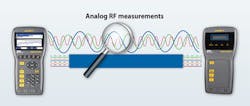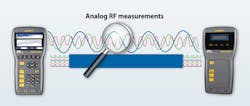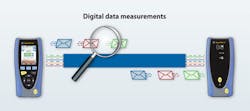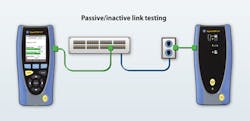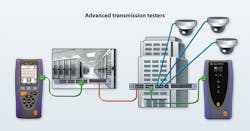An introduction to transmission testing in the LAN environment
From the September, 2014 Issue of Cabling Installation & Maintenance Magazine
New test equipment puts the capabilities once used exclusively by WAN engineers into the hands of LAN cabling installers and system integrators.
by Dan Payerle, Ideal Networks
In the late 1970s the use of computers in business operations of large corporations was becoming common, but there was little commonality in the network cable used by different computer-system manufacturers. Different computer systems communicated using different protocols, resulting in a variety of cables and connectors, each having its own physical and electrical characteristics. The numerous different cable and connector options made prewiring a building with network cable that could support every computer system nearly impossible, meaning proprietary network cable had to be installed to support the requirements of a particular computer system. Proprietary cable had a major drawback when a computer system needed to be upgraded. The user had to either stay with the same system vendor to avoid changing the cabling; or if they wanted to change computer systems they incurred the additional time and expense of recabling the building or modifying the existing network cable to make it compatible with a new computer system.
In 1983 requirements for Ethernet were published by the IEEE as the 802.3 standard, which meant a non-proprietary networking protocol was now available for use. Adapters could be used to convert an existing network with proprietary protocols and wiring schemes to standard Ethernet. In 1990 the 10Base-T standard was published as IEEE 802.3i, specifying 10-Mbit/sec Ethernet over balanced twisted-pair cabling. By the 1990s Ethernet had become the dominant computer networking protocol because it was reliable, inexpensive and easy to deploy.
Because of Ethernet's ubiquity and other advantages, it has become the preferred protocol in many systems outside of computer networks. Traditional business phone systems are giving way to Voice over Internet Protocol (VoIP) and IP CCTV systems are now outselling analog CCTV by a comfortable margin. Ethernet is also making inroads into access control, environmental control, lighting control, distributed audio/video, electronic signage and many other systems. Ethernet is available at several data rates ("speeds") and the most common speed currently being deployed is Gigabit Ethernet (1 Gbit/sec; 1,000 Mbits/sec), which requires the performance provided by Category 5e/Class D or better cable and is defined by the IEEE as 802.3ab.
In 1991 the Telecommunications Industry Association (TIA) published the TIA-568-A commercial building cabling standard, which created a specification for structured cabling. Structured cabling systems describe the physical layout of cabling within a building and the performance requirements of the cable and connectors in the system. Since then, both TIA and ISO (International Organization for Standardization) have continued to update their respective cabling standards to keep pace with the increasing speeds of Ethernet and other applications. The ISO-11801 series of standards defines a Class system that begins at Class C supporting a maximum frequency of 16 MHz and ends at Class FA supporting a maximum frequency of 1,000 MHz. The TIA-568 standards define a Category system ranging from Category 3 at 16 MHz to Category 6A at 500 MHz.
The intent of both ISO and TIA is to create performance standards that are generic and not specific to any one application. The rationale behind generic performance standards is that a designer or installer may not know what applications a network user is going to run over the cable system. Therefore the cable needs to be designed and tested to allow for any application within a given frequency range. TIA and ISO specify a suite of measurements that may be used to test the electrical properties of LAN cable, ensuring that it meets the performance requirements for Category 5e, 6, or 6A.
Cable certifiers and WAN testers
Measurements such as near-end crosstalk (NEXT), return loss, power-sum NEXT and others are carried out by products called LAN cable certifiers. Certifiers operate by sweeping the cable over a range of frequencies, making precise measurements of very low signal levels. The level of precision provided by certifiers comes with a very high price tag, often placing them out of reach of many installers, thereby leaving cable systems untested.
Wide area network (WAN) testing is approached from a completely different perspective. Instead of testing the electrical properties of the cable, WANs are tested by measuring the transmission of data from one point to another using a product called a transmission tester. With this testing approach, the type of cable or its performance rating is irrelevant; the tester is blind to the media between the two handsets. A transmission tester is a pair of active testers that establish a link across a cable or network and transmit data at varying rates to establish the maximum throughput that can be achieved without error. A transmission tester does not "care" about the category being tested; in fact they usually do not have a setting for cable type. Its only purpose is to transmit data between the two handsets and report the resulting error rate or throughput achieved.
WAN transmission testers are often able to test many different protocols, which add cost. In LANs, testing Ethernet is likely all that is needed because virtually every system in a commercial environment that needs to communicate is using Ethernet. By supporting only Ethernet, test equipment manufacturers are able to significantly reduce the cost of LAN transmission testers and give installers the ability to prove the performance of network cable by measuring its ability to support actual data transmission rather than by measuring the electrical characteristics to infer that the cable will support data transmission.
Transmission testing is a term that is not recognized by most LAN installers who have had only cable certifiers to test their installations against accepted performance standards. Transmission testing can be thought of as a direct test of the network owner is buying from the installer or designer. Ultimately the network owner is not paying for cable; they are paying for the ability to get data from Point A to Point B as quickly and reliably as possible; the cable is simply a means to an end. For all their flexibility, wireless systems do not provide consistent reliable connections that business-critical applications demand, never mind the security concerns. For now and the foreseeable future, direct cabling will continue to provide the most secure and reliable connection to a network.
Transmission testing
A transmission tester typically operates in one of two ways. It will transmit data at a fixed rate and report the number of errors (dropped data frames/packets) detected during the test, or it will transmit data at varying rates and frame sizes, reporting the highest data rate achieved without generating errors. LAN installers who are not experienced in configuring transmission testers and need to test a recognized performance standard to satisfy customer requirements are best served with a simplified fixed-rate tester. For example, Ideal's SignalTEK CT and SignalTEK II FO test for compliance with IEEE 802.3ab, the Gigabit Ethernet standard, which specifies the maximum allowable frame loss for a transmission test to pass.
While transmission testing may sound complicated to the uninitiated, it can be quite simple with a tester that is designed with its user in mind. LAN installers are accustomed to operating certifiers that are generally straightforward to use if properly configured. The operator needs to set the Category or Class of cable to be tested and proceed to certify each link on the job. However, technicians sometimes test jobs with the certifier set to the wrong cable type. If the certifier was inadvertently set to test Category 5e and the cable installed was Category 6, the only remedy is to retest the entire job, wasting money and potentially causing the installer to miss deadlines.
A well-designed transmission tester is easier to use and will prevent time-wasting operator error. Because transmission testers are blind to cable type, there is generally little for the technician to configure. A transmission tester is going to attempt to transmit data regardless of the connected cable type. For a Gigabit Ethernet test, if the tester is connected to a Category 3 link it will most certainly fail. A Category 5e link should pass as long as it is constructed of quality materials, is not too long and is properly terminated. Because of the additional performance headroom provided by Category 6 cabling (which exceeds the minimum performance requirements for Gigabit Ethernet), links will likely support error-free transmission even if too long or poorly terminated. Transmission testers treat each of the above examples the same-the cable will either support error-free transmission or it will not. The operator does not need to make any configuration changes to the tester based on the type of cable being tested.
Live-testing capability
Another benefit of LAN transmission testers is in addition to testing only cable links, some models may support testing through live network switches. The capability of testing through switches means an installer or integrator is not limited to testing only the cable; they may now test the performance of the entire network. This ability is very helpful for integrators who are upgrading or adding additional systems that use IP/Ethernet. Take the example of a company planning to upgrade its existing analog CCTV system to a new IP/Ethernet CCTV system, and the owner wants to avoid installing a separate LAN for the cameras. A CCTV integrator who has the proper type of LAN transmission tester may configure the tester to generate data at a rate equivalent to what the proposed CCTV system will generate. The tester can be connected to the customer's existing network and transmit the additional data load through the network. While running, the transmission tester will count any dropped frames in the event the network switch(es) cannot handle the simulated data load in addition to the existing LAN traffic. The result of this test tells the integrator whether or not to proceed with the installation of IP cameras on the existing network. Should the test fail by dropping data frames, the integrator can make an informed recommendation to the network's owner that an upgrade is needed to avoid affecting the performance of their existing business systems.
No cable certifier is capable of testing live circuits; this very useful feature is unique to transmission testers. Even if the customer requires a full cable certification, the ability to transmission test a live network saves integrators and network owners time and surprises by quantifying the margin available in the entire network-not only the cabling.
LAN cabling should be tested to a recognized standard to protect the installer and prove to the network owner that they are receiving the performance they paid for. Cable certifiers have been used for more than 20 years to provide this service, but at high cost and complexity. The penetration of Ethernet into nearly every communication system in modern commercial buildings means installers and integrators are no longer limited to certifiers as their only tool to prove network cable performance. Certifiers absolutely have a role in testing data cabling in situations in which cabling warranties are involved or when customers specify full ANSI/TIA-568 or ISO/IEC-11801 certification.
Transmission testers provide installers with the ability to test cabling or active networks ensuring they transmit data without error, which ultimately is what the network owner desires. The cabling is nothing more than a road for the data to follow, and transmission testers test the data rather than the road. With a cost that is one-fourth or less than a certifier, transmission testers allow contractors to equip more crews with equipment that documents the performance of an installation, reducing time wasted by transporting certifiers between projects. Both are valid test types; they simply measure different parameters against different standards to provide installers the confidence that their installation performs as expected.
Dan Payerle is business unit manager for network testers, covering the United States, with Ideal Networks (www.signaltekct.com, www.signaltek2.com).
